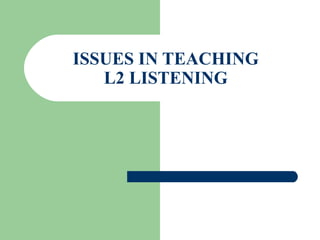
Listening
- 1. ISSUES IN TEACHING L2 LISTENING
- 2. 1. DIFFICULTY FACTORS IN LISTENING INPUT CHARACTERISTICS LANGUAGE Speech rate Unfamiliar accent Numbers of speakers Similarity of voices Use of less frequent vocabulary
- 3. 1. DIFFICULTY FACTORS IN LISTENING INPUT CHARACTERISTICS LANGUAGE Grammatical complexity Embedded idea units Complex pronoun reference
- 4. 1. DIFFICULTY FACTORS IN LISTENING INPUT CHARACTERISTICS EXPLICITNESS Implicit ideas Lack of redundancy
- 5. 1. DIFFICULTY FACTORS IN LISTENING INPUT CHARACTERISTICS ORGANIZATION Events narrated out of natural time order Examples preceding the point they illustrate
- 6. 1. DIFFICULTY FACTORS IN LISTENING INPUT CHARACTERISTICS CONTENT Unfamiliar topics Number of things and people referred to Unclear indication of the relative importance of protagonists in the text Shifting relationships b/w protagonists Abstract content
- 7. 1. DIFFICULTY FACTORS IN LISTENING INPUT CHARACTERISTICS CONTEXT Lack of visual or other support
- 8. 1. DIFFICULTY FACTORS IN LISTENING TASK CHARACTERISTICS Tasks tend to be more difficult when they require Processing of more details Integration of information from different parts of the text Recall of gist ( For example, writing a summary) rather than exact content
- 9. 2. AUTHENTICITY OF TEXT & TASK AUTHENTICITY OF TEXT Authentic in the context is generally defined as “ not designed or recorded for non- native speakers, or for language learning purposes. A text was genuine if containing the sort of language typical of the genre in actual use The term “ authentic” , Widdowson reserved for the appropriacy from listeners or readers
- 10. 2. AUTHENTICITY OF TEXT & TASK AUTHENTICITY OF TASK Making learning tasks as realistic as possible Ex: the information gap in CLT.
- 11. 3. STRATEGY INSTRUCTION Strategy instruction for determining SIMT Setting (Where and When) Interpersonal relationships ( Who) Mood ( How => tone) Topic ( What and Why)
- 12. 4. SKILLS TRAINING Discriminating b/w similar sounds Coping with and processing “ fast speech” Processing stress and intonational differences Processing the meaning of different discourse markers Understanding communicative functions and the non- one- to – one equivalence b/w form and function
- 13. 4. CONCLUSION LISTENING PROCESSES are COMPLEX LISTENING COMPREHENSION is DIFFICULT ----------------------------------------------------------------- Endorsing the importance of a strategic approach to L2 listening instruction Striking a balance b/w practice- focused listening skills work and practice in the use of strategies